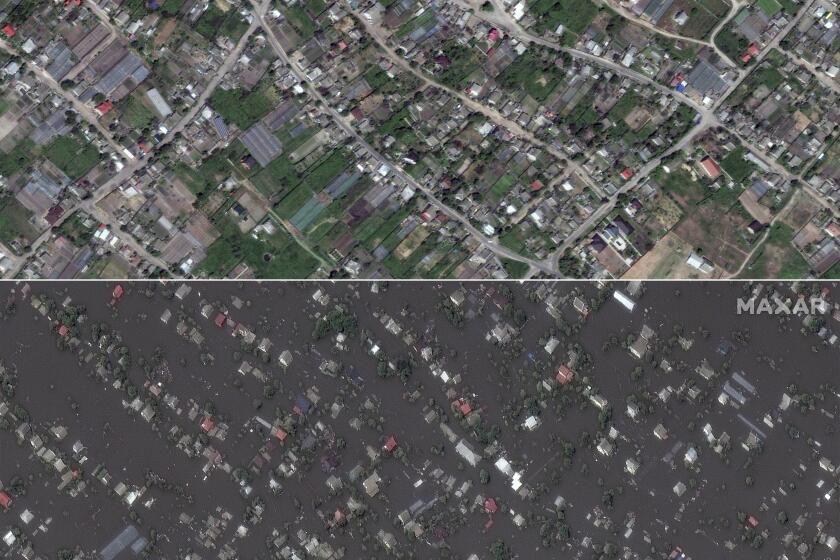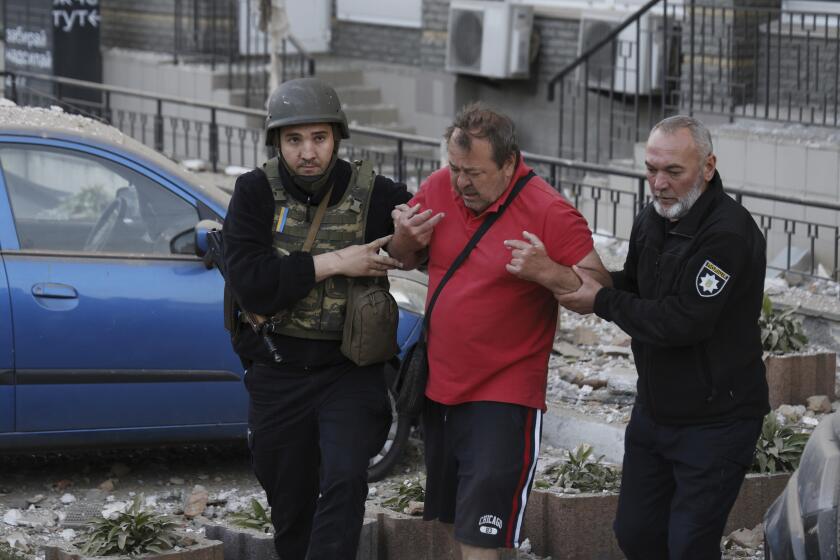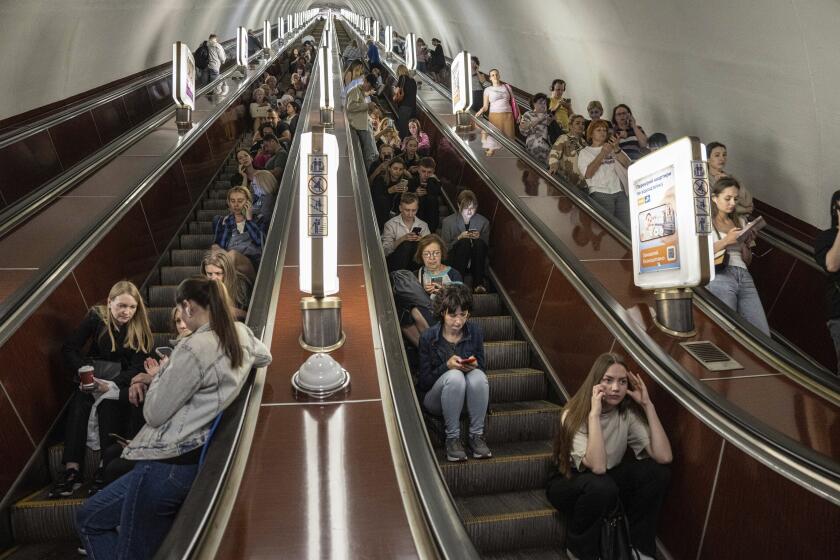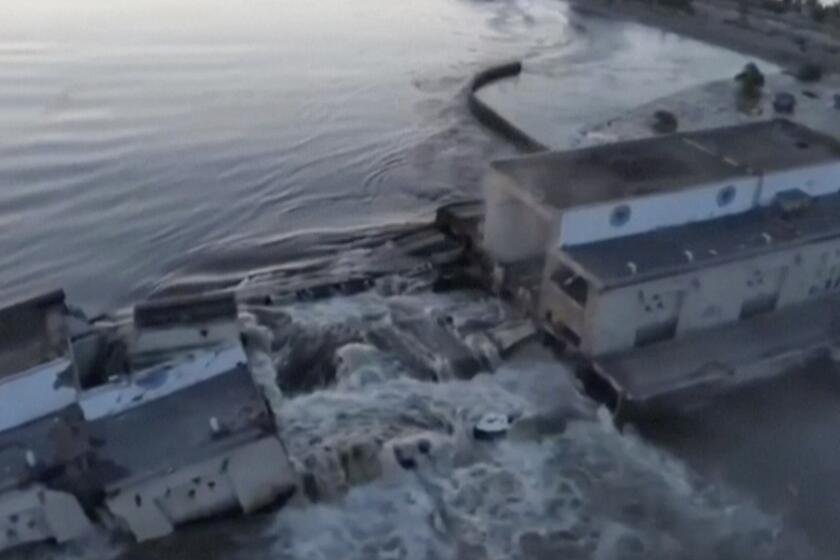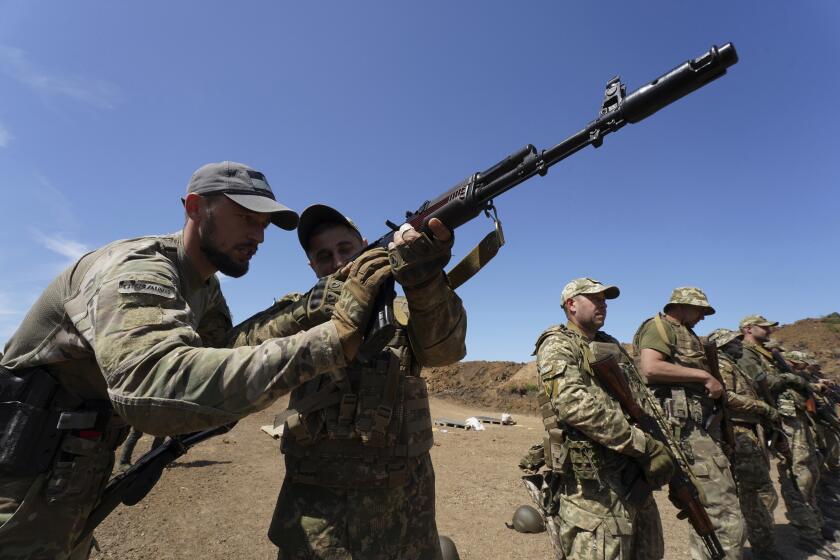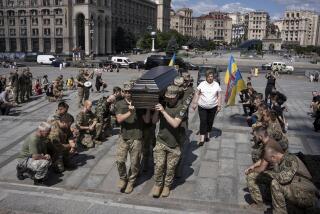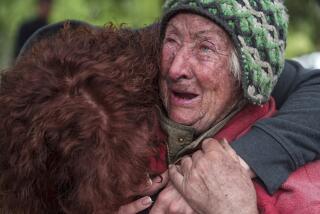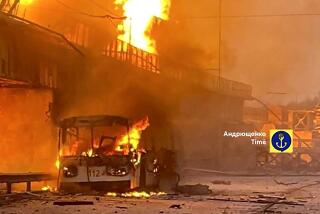Russia shells Ukrainian city inundated by dam collapse after Zelensky visits area
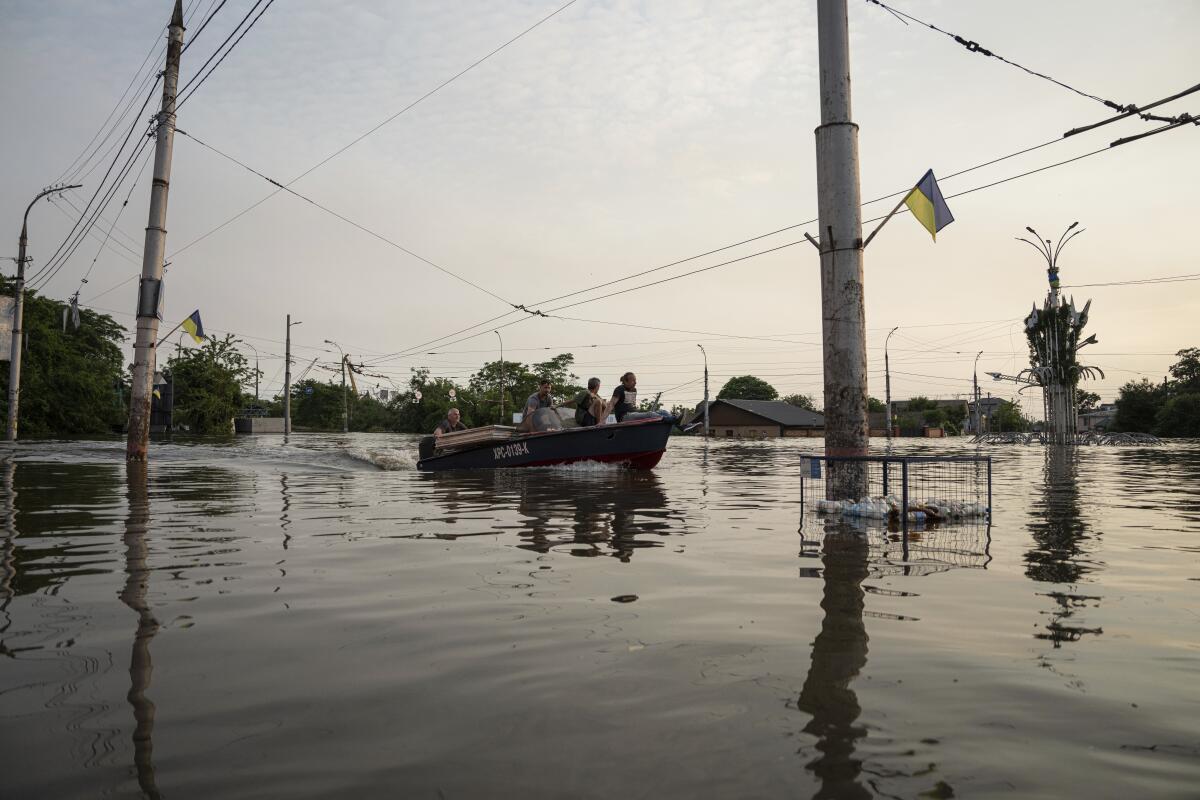
- Share via
KHERSON, Ukraine — Russian forces Thursday shelled a southern Ukrainian city that was inundated in a catastrophic dam collapse, Ukrainian officials said, forcing a suspension of some rescue work hours after President Volodymyr Zelensky went to the area to assess flood damage.
The fresh fighting returned security issues to the region, two days after the collapse of the Kakhovka dam on the Dniper River set off a scramble to evacuate residents in dozens of flooded areas and get aid to those still there.
Officials on both sides said at least 14 people were killed in the flooding, thousands are homeless and tens of thousands are without drinking water after the collapse. Kyiv accused Moscow of blowing up the dam and its associated hydropower plant, which the Kremlin’s forces controlled, while Russia said Ukraine bombarded it.
The ensuing flooding has ruined crops, displaced land mines, wrought widespread environmental damage and set the stage for long-term electricity shortages. Drone footage captured by the Associated Press showed the ruined dam falling into the flooded river, along with hundreds of submerged homes, greenhouses and even a church.
Before-and-after images show a dam that collapsed Tuesday causing flooding and devastation in southern Ukraine.
Upriver from the dam, a supply of water used to cool Europe’s largest nuclear power plant was nearing critically low levels, Ukraine’s state hydroelectric company said. But the United Nation’s atomic energy watchdog said Wednesday that work was underway to ensure the Zaporizhzhia nuclear power plant had enough water in reserve to cool its shutdown reactors, in case supplies fell too much.
Zelensky’s office said Moscow’s forces also continued to shell Ukrainian-held areas near the nuclear plant, which is under Russian control.
The high water brought new misery and death to a country suffering uncounted casualties after 15 months of war.
Vladimir Leontyev, the Kremlin-installed mayor of Nova Kakhovka, a Russian-occupied city adjacent to the dam, told Russian state TV that five residents had died in the flooding. And Mykolaiv regional Gov. Vitalii Kim said one person had died in that region northwest of the city of Kherson.
Yevhen Ryshchuk, the mayor of Oleshky to the south who fled the town after the Russians took over, told the Associated Press that residents told him eight people had died in the flooding, with corpses floating to the surface. His tally could not immediate be verified.
Residents of Oleshky have accused Russian authorities in the town of not doing enough to help civilians, and they have formed a group of more than 8,000 that is sharing messages about information such as stranded and trapped locals.
The Ukrainian military’s surrender hotline, dubbed ‘I Want to Live,’ is enticing some Russian soldiers to quit the battlefield as the war drags on.
Ryshchuk said Russian forces are not letting people leave and are instead confiscating boats from residents and volunteers. This was confirmed by two volunteers, who said the Russian military was taking away boats brought by volunteers. Volunteer Yaroslav Vasiliev said the Russian military seized three boats Wednesday.
From afar, relatives of Oleshky residents said Russian forces were evacuating only Russian passport holders.
“My relatives said Russian soldiers were coming up to the house today by boat, but they said they would only take those with Russian passports,” said Viktoria Mironova-Baka, 32, speaking by phone from Germany.
In Kherson, the largest municipality affected, Russian shelling echoed not far from a square where emergency crews and volunteers were dispensing aid. Nine people were wounded, including two emergency workers, a policemen, a volunteer from Germany.
As shells landed in floodwaters, rescue workers temporarily suspended efforts to retrieve stranded residents and pets in an area that Zelensky had visited only hours earlier, officials said.
Russian air defenses stopped eight drones converging on Moscow, officials said Tuesday, in an attack that Russian authorities blamed on Ukraine.
“The strikes began during evacuation of the residents, whose houses were flooded,” the Internal Affairs Ministry said. “Russia has abandoned people in calamity in the occupied part of the Kherson region. It continues to prevent Ukraine from saving the most valuable — human lives.”
Zelensky visited an aid distribution point and a medical facility in Kherson, ordering officials to provide a “fair valuation” of the devastation to compensate residents, his office said in an update.
Russian President Vladimir Putin “has no plans at the current moment” to visit the affected Moscow-occupied areas, Kremlin spokesman Dmitry Peskov told journalists.
Regional Gov. Vladimir Saldo, who was installed by Moscow to oversee the area that Russia occupies, accused Ukrainian troops of firing at an evacuation point in Hola Prystan, a Russian-occupied town. Saldo said in a Telegram post that two people, including a pregnant 33-year-old woman, were killed and that two people were wounded. It was not immediately possible to verify his account.
Fighting has intensified along the more than 620-mile front line from Kherson on the Black Sea to Ukraine’s border with Russia — in what some experts and officials say could be part of a long-expected Ukrainian counteroffensive. Kyiv has said it won’t announce the start of any such campaign.
Concerns around civilian safety have spiked in Ukraine, as officials announced that an inspection had found nearly a quarter of the country’s air-raid shelters locked or unusable.
The destruction of the dam prompted the United Nations and local authorities to say that the most immediate concerns were access to fresh water and avoiding contact with water contaminated by explosives and industrial chemicals.
Officials say more than 6,000 people have been evacuated from both sides of the river. The true scale of the disaster is yet to emerge in an affected area that was home to more than 60,000 people.
In areas that they control, Russian-appointed authorities said nearly two dozen people have been hospitalized, 4,280 people have been evacuated and some 14,000 buildings have been flooded.
The rupture of the dam that impounds Ukraine’s largest reservoir released a torrent of water, raising fears of widespread damage and flooding.
Russian officials say the destruction of the dam will eventually halt freshwater supplies to southern Ukraine and Russian-controlled Crimea, even though the peninsula has enough fresh water for now — with its reservoirs 80% full.
Ukrainian authorities cut off freshwater supplies to Crimea after Moscow’s illegal annexation of the peninsula in 2014, and Putin cited the need to restore them as one of the main reasons for his decision to invade Ukraine.
Regional Gov. Oleksandr Prokudin said roughly 230 square miles of the region was submerged — more than two-thirds of that on the Russian-controlled eastern bank.
Secretary of State Antony J. Blinken says there can be no cease-fire in Ukraine unless it’s part of a deal that includes Russia’s military withdrawal.
French President Emmanuel Macron tweeted that the destruction of the dam was an “attack” and an “atrocious act,” without saying who was to blame. Paris said it was sending aid, including water purifiers, 500,000 water purification tablets and hygiene kits to help people displaced by the disaster.
Ukrainian officials have accused Russia of purposely destroying the dam, which is in an area controlled by Russian forces.
President Alexander Lukashenko of Belarus, a key Putin ally, claimed Ukraine blew up the dam to distract attention from what it described as a botched Ukrainian attempt to launch a counteroffensive.
Ukrainian authorities have largely kept quiet about recent development on the battlefield amid growing reports of intensified fighting that could add up to the long-awaited counteroffensive.
More to Read
Sign up for Essential California
The most important California stories and recommendations in your inbox every morning.
You may occasionally receive promotional content from the Los Angeles Times.
